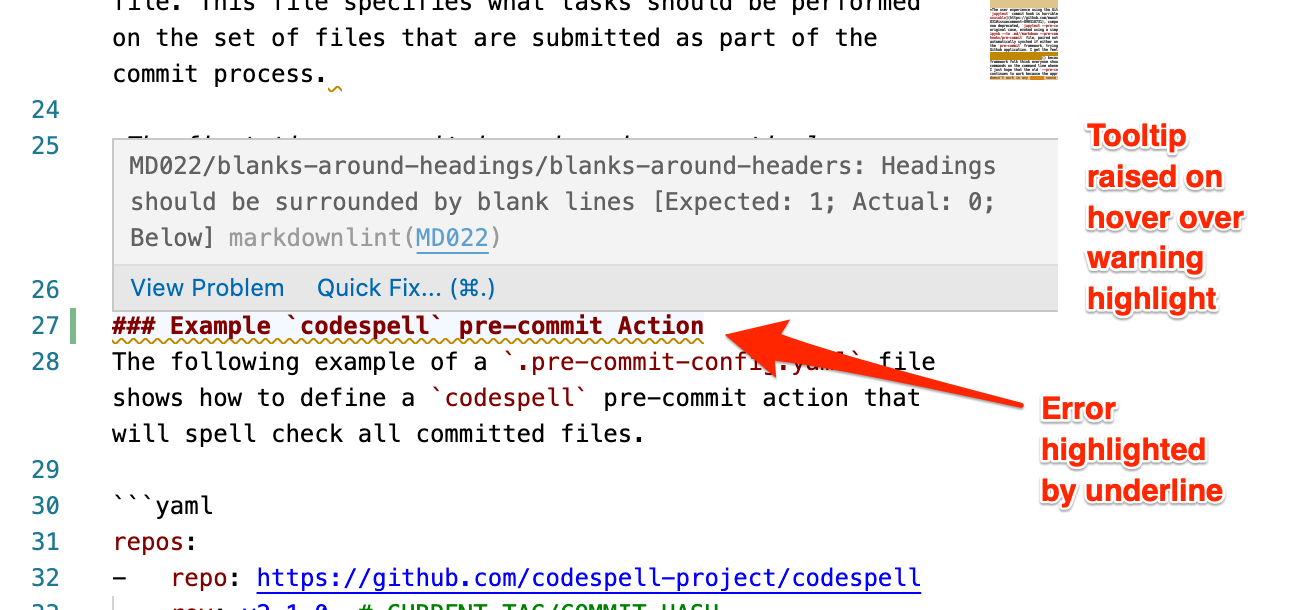Editor Automation¶
Although this may not typically be classed as “automation”, it is worth considering how editor tools or extensions can be used to provided “live” automation support doing notebook production or maintenance activity. Live support is available for spellchecking and linting Markdown text, formatting and linting code, and previewing generated content, for example.
Spellchecking Markdown Text¶
In the classic notebook environment, the spellchecker extension provides live highlighting of spelling errors identified using the typo.js package.

A complementary JupyterLab spellchecker that also makes use of typo.js is also available.
In a VS Code environment, spelling errors can be highlighted as you type using extensions such as valentjn.vscode-ltex grammar/spell checking extension.

Formatting Code¶
Code formatting is available in classic notebooks via the code_prettify extension which provides toolbar buttons for updating the style of a selected code cell, or all code cells in a notebook, using yapf or autopep8.

The same extension can be extended to support black formatting.
For a corresponding JupyterLab extension, see ryantam626/jupyterlab_code_formatter.
In the VS Code editor, the Python extension supports code formatting using autopep8, black or yapf.
Linting Markdown and Code¶
The mattijn/pycodestyle_magic classic notebook extension can be configured to apply flake8 style linting to the contents of code cells when they are run.

Contraventions of style rules are highlighted as code cell stream output. The linting is enabled in a notebook using IPython line magic.
In the VS Code editor, the Python extension natively supports linting using pylint.
The VS Code editor also supports the DavidAnson.vscode-markdownlint extension which highlights rule contraventions with the editor.

Generated Diagram Previews¶
In publishing workflows based around Sphinx, such as Jupyter Book, several extensions are available that can generate diagrams from a simple Markdown friendly script.
For example, the mgaitan/sphinxcontrib-mermaid and the bavovanachte/sphinx-wavedrom contributed Sphinx extensions are capable of rendering Mermaid and wavedrom scripted diagrams respectively from scripts wrapped in MyST styled code fenced blocks.

With a slight change to the syntax when labeling the code fenced block, the shd101wyy.markdown-preview-enhanced can preview the rendered diagram in the VS Code Markdown preview window.

Warning
An issue has been raised to see whether the MyST style label could be supported by the extension.
It is also possible to create some simple block cell magics that can be used render diagrams from appropriate diagram script in a classic Jupyter notebook.

Note
While a transformation script does not currently exist to support this, it should be easy enough to create a transformer that will map between magicked diagram generating code cells and appropriately labeled code fenced blocks to allow for generating and previewing diagrams in a Jupyter notebook user interface and then rendering via a Sphinx publication workflow, or editing and previewing the diagrams via a Markdown source file in VS Code and then generating a corresponding notebook file that utilises block cell magics.